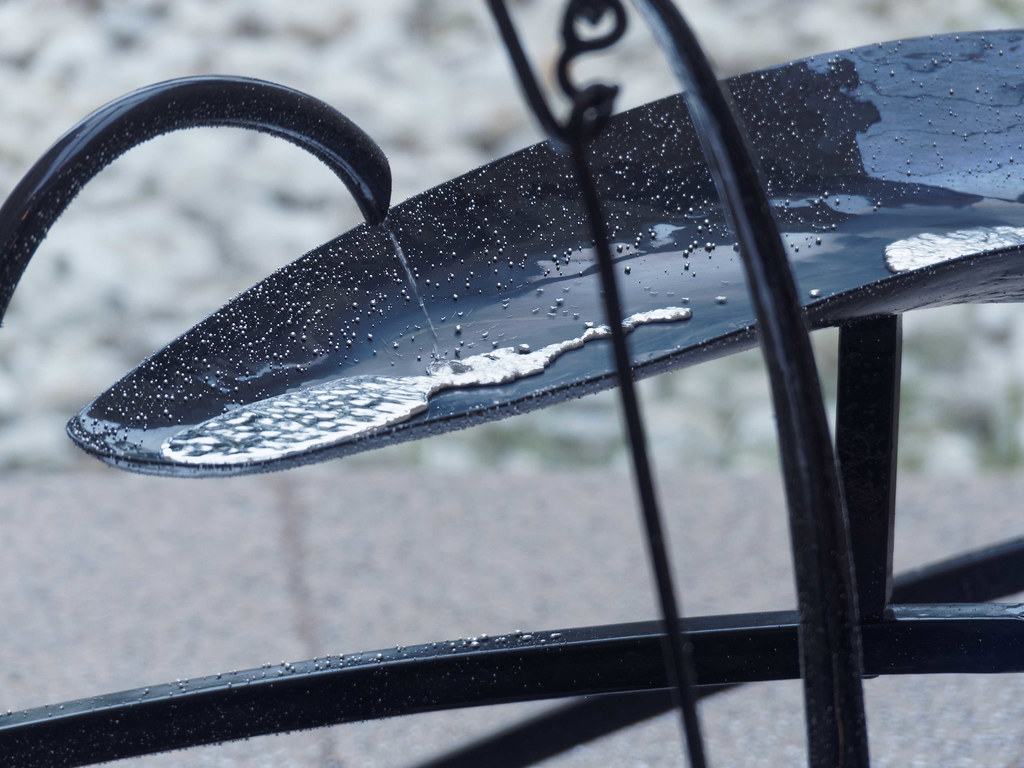At the Joan Miró Foundation, a contemporary museum on Montjuïc hill in Barcelona, is a fascinatingly deadly piece of art—a fountain of mercury. It’s a simple, almost childlike creation consisting of a single, standing pipe that releases a narrow stream of liquid mercury into a series of curving aluminum troughs. After swirling and sloshing in a couple of basins and steps built along the way, the toxic liquid strikes a paddle like thing before it falls into a circular pool. The liquid striking the paddle causes it to sway as if catching the wind, and the whole contraption moves a series of rods causing an iron pendant to gently flutter. The pendant spells out the word “ALAMADEN”.
Photo credit: Jeremy Brooks/Flickr
Almaden is a small mining town located approximately 300 km south of Madrid, in Spain. For more than two millennia, the cinnabar mines of Almaden were the largest provider of mercury to the world. This liquid metal with unusual physical properties is extracted from a reddish mineral called cinnabar, which is found in plenty in Almadén.
Almadén was founded by the Romans who used the mineral as pigment for its vibrant reddish hue. Later, the mineral found use in Chinese medicines as it was thought that ingesting the liquid gave men longevity and even immortality, when the reverse was true. Many Chinese emperors and nobles succumbed to mercury poisoning over the centuries. The first emperor of China, Qin Shi Huang, died after taking mercury pills that his physicians had prescribed to give him eternal life. Emperor Xuānzong of the late Tang dynasty became increasingly irritable and paranoid—a sign of mercury poisoning—during his final days. The 9th century Egyptian ruler, Khumarawayh ibn Ahmad ibn Tulun, reportedly lay on air-filled cushions floating over a bath of mercury while his attendants rocked him to sleep.
Cinnabar, the most common source ore of mercury.
At that time the toxicity of mercury was not understood. The metal was frequently used in many industrial processes, such as the production of felt. Felt, in turn, was used in the manufacturing of hats in 18th and 19th century England. Many workers in the hat making industry developed a range of behavioral changes such as irritability, memory loss, delirium and hallucinations, giving rise to the expression “as mad as a hatter”.
The value of mercury increased greatly during the 16th century when it was discovered that gold and silver fused easily with mercury to form an alloy—a property that miners found very useful to extract gold, silver and other precious metals from ores. The demand for mercury grew, and so did the Almaden's importance as a center of mining and industry. During the Spanish conquest of the New World, mercury extracted from Almaden's mines by forced labor was sent to Central America to purify the rich silver deposits there, and the refined silver then shipped back to Spain. Such terrible were the working conditions in the mines that many parents were known to purposefully maim their children to keep them from having to work the mines.
Photo credit: www.fmirobcn.org
In 1936, the Spanish civil war broke out and General Franco's Falangist movement took control of the mercury mine after besieging the town of Almaden. This deprived the Spanish government of the financial revenues from the export of mercury, as well as access to the metal which was used in the manufacture of firearms. In an effort to garner international support, the Republican government commissioned the artist Alexander Calder to create a monument denouncing the siege of Almadén. The fountain was presented during the 1937 World Exhibition in Paris.
Later, the fountain was donated to Joan Miró Foundation, where it was once openly approachable. Today, it lies behind a glass case to protect visitors from the poisonous fumes which emanate from the fountain.
Alexander Calder in front of Picasso's Guernica with his Mercury Fountain in the Spanish Pavilion of the 1937 World Exhibition in Paris.
Splashes of mercury around the fountain. Photo credit: StevenBrace/Flickr
A model of the Mercury Fountain. Photo credit: Museo Nacional Centro de Arte Reina Sofía
Photo credit: David Merrett/Flickr



















Comments
Post a Comment